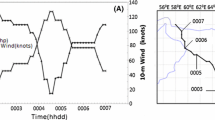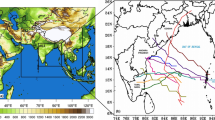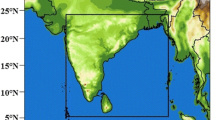Abstract
The surface enthalpy fluxes (latent and sensible heat fluxes) provide the necessary energy to intensify tropical cyclones (TCs). The surface momentum fluxes modify the intensity of TCs. Various parameters affect the surface fluxes. Drag and enthalpy exchange coefficients are known as parameters that lead to ambiguity in the surface fluxes. Thus, for simulating a TC, various drag and enthalpy exchange coefficients are tested in numerical simulations. Exchange coefficients directly relate to roughness lengths. The main goal of this study was comparing derived roughness lengths of the COAWST (WRF-SWAN online coupling) and WRF models with one another. The TC Gonu formed over the Arabian Sea in 2007 was selected for this study. Employing self-reliant WRF, it is found that track and intensity of the TC Gonu can be best simulated when Donelan parameterization is applied for momentum roughness length and Large-Pond parameterization for enthalpy roughness length. In the second section, simulations were conducted in the coupled mode using the COAWST model with the Large-Pond parameterization (for the enthalpy roughness length). Results cleared that the use of Oost parameterization leads to a high overestimation of simulated momentum roughness length compared with other parameterizations while both the Drennan and Taylor parameterizations were somewhat close to reality. Differences of simulated maximum 10-m wind speed between the Oost parameterization and other parameterizations were more than differences of their simulated minimum central pressure. These results proved that the momentum roughness length affects the maximum 10-m wind speed more significantly than the minimum central pressure. In the last section, a simulation was performed using the COAWST model with the Donelan–Large-Pond parameterization. In this simulation, only 10-m wind speed from the WRF model transferred to the SWAN model. The results showed that simulated wave heights in the open ocean were in good agreement with the results of other researchers. In general, the SWAN model performance is evaluated satisfactorily while the parameterizations using the wave information need to be more investigated.









Similar content being viewed by others
Notes
Carlson-Boland parameterization (Carlson and Boland 1978) was used before v3.7. The sensible heat roughness length ZT was equal to Z0, which results in CD = CH for this option. The latent heat roughness length ZQ was less than or equal to Z0, which results in zQ ≤ zT = zo.
References
Alimohammadi M, Malakooti H (2018) Sensitivity of simulated cyclone Gonu intensity and track to variety of parameterizations: advanced hurricane WRF model application. J Earth Syst Sci 127(3):41
Barbariol F, Alves JHG, Benetazzo A, Bergamasco F, Bertotti L, Carniel S, Cavaleri L, Chao YY, Chawla A, Ricchi A, Sclavo M, Tolman H (2017) Numerical modeling of space-time wave extremes using WAVEWATCH III. Ocean Dyn 67(3–4):535–549
Bauer P, Thorpe A, Brunet G (2015) The quiet revolution of numerical weather prediction. Nature 525(7567):47–55
Black PG, D'Asaro EA, Drennan WM, French JR, Niiler PP, Sanford TB, Terrill EJ, Walsh EJ, Zhang JA, (2007) Air–Sea Exchange in Hurricanes: Synthesis of Observations from the Coupled Boundary Layer Air–Sea Transfer Experiment. Bull Am Meteorol Soc 88(3):357–374
Booij N, Ris R, Holthuijsen LH (1999) A third-generation wave model for coastal regions: 1. Model description and validation. J Geophys Res Oceans 104(C4):7649–7666
Carlson TN, Boland FE (1978) Analysis of urban-rural canopy using a surface heat flux/temperature model. J Appl Meteorol 17(7):998–1013
Charnock H (1955) Wind stress on a water surface. Q J R Meteorol Soc 81(350):639–640
Chen SS, Price JF, Zhao W, Donelan MA, Walsh EJ (2007) The CBLAST-Hurricane program and the next-generation fully coupled atmosphere–wave–ocean models for hurricane research and prediction. Bull Am Meteorol Soc 88(3):311–318
Chen Y, Zhang F, Green BW, Yu X (2018) Impacts of ocean cooling and reduced wind drag on hurricane Katrina (2005) based on numerical simulations. Mon Weather Rev 146(1):287–306
Davis CA, Bosart LF (2001) Numerical simulations of the genesis of Hurricane Diana (1984). Part I: Control simulation. Mon Weather Rev 129(8):1859–1881
Davis C, Wang W, Chen SS, Chen Y, Corbosiero K, DeMaria M, Dudhia J, Holland G, Klemp J, Michalakes J, Reeves H, Rotunno R, Snyder C, Xiao Q (2008) Prediction of landfalling hurricanes with the advanced hurricane WRF model. Mon Weather Rev 136(6):1990–2005
Davis C, Wang W, Dudhia J, Torn R (2010) Does increased horizontal resolution improve hurricane wind forecasts? Weather Forecast 25(6):1826–1841
Deshpande M, Pattnaik S, Salvekar PS (2010) Impact of physical parameterization schemes on numerical simulation of super cyclone Gonu. Nat Hazards 55(2):211–231
Donelan M, Haus B, Reul N, Plant W, Stiassnie M, Graber H, Brown OB, Saltzman E (2004) On the limiting aerodynamic roughness of the ocean in very strong winds. Geophys Res Lett 31(18)
Drennan WM, Taylor PK, Yelland MJ (2005) Parameterizing the sea surface roughness. J Phys Oceanogr 35(5):835–848
Dudhia J (1989) Numerical study of convection observed during the winter monsoon experiment using a mesoscale two-dimensional model. J Atmos Sci 46(20):3077–3107
Dudhia J, Hong S-Y, Lim K-S (2008) A new method for representing mixed-phase particle fall speeds in bulk microphysics parameterizations. J Meteorol Soc Japan Ser II 86:33–44
Dysthe K, Krogstad HE, Müller P (2008) Oceanic rogue waves. Annu Rev Fluid Mech 40:287–310
Emanuel KA (1995) Sensitivity of tropical cyclones to surface exchange coefficients and a revised steady-state model incorporating eye dynamics. J Atmos Sci 52(22):3969–3976
Fairall C, Bradley EF, Hare J, Grachev A, Edson J (2003) Bulk parameterization of air–sea fluxes: updates and verification for the COARE algorithm. J Clim 16(4):571–591
Garratt JR (1994) The atmospheric boundary layer. Earth Sci Rev 37(1–2):89–134
Golshani A, & Taebi S (2008) Numerical modeling and warning procedure for Gonu super cyclone along Iranian Coastlines Solutions to Coastal Disasters 2008 (pp. 268-275)
Green BW, Zhang F (2013) Impacts of air–sea flux parameterizations on the intensity and structure of tropical cyclones. Mon Weather Rev 141(7):2308–2324
Holthuijsen LH, Powell MD, Pietrzak JD (2012) Wind and waves in extreme hurricanes. J Geophys Res Oceans 117(C9)
Hong S-Y, Dudhia J, Chen S-H (2004) A revised approach to ice microphysical processes for the bulk parameterization of clouds and precipitation. Mon Weather Rev 132(1):103–120
IMD (2008) Track of storm and depressions over the Indian Seas during 1891–2008; Cyclone e-Atlas published by IMD, http://www.imd.gov.in/section/nhac/dynamic/
Jacob R, Larson J, Ong E (2005) M× N communication and parallel interpolation in Community Climate System Model Version 3 using the model coupling toolkit. Int J High Perform Comput Appl 19(3):293–307
Jarosz E, Mitchell DA, Wang DW, Teague WJ (2007) Bottom-up determination of air-sea momentum exchange under a major tropical cyclone. Science 315(5819):1707–1709
Kain JS (2004) The Kain–Fritsch convective parameterization: an update. J Appl Meteorol 43(1):170–181
Kanase R, & Salvekar P (2011) Numerical simulation of severe cyclonic storm LAILA (2010): sensitivity to initial and cumulus parameterization schemes. Paper presented at the Proceedings of Disaster Risk Vulnerability Conference
Krishnamurti T, Pattnaik S, Stefanova L, Kumar TV, Mackey BP, O’shay A, Pasch RJ (2005) The hurricane intensity issue. Mon Weather Rev 133(7):1886–1912
Kumar A, Done J, Dudhia J, Niyogi D (2011) Simulations of Cyclone Sidr in the Bay of Bengal with a high-resolution model: sensitivity to large-scale boundary forcing. Meteorog Atmos Phys 114(3–4):123–137
Large W, Pond S (1981) Open ocean momentum flux measurements in moderate to strong winds. J Phys Oceanogr 11(3):324–336
Larson J, Jacob R, Ong E (2005) The model coupling toolkit: a new Fortran90 toolkit for building multiphysics parallel coupled models. Int J High Perform Comput Appl 19(3):277–292
Marcucci G, Pierangeli D, Agranat AJ, Lee RK, DelRe E, Conti C (2019) Topological control of extreme waves. Nat Commun 10(1):1–8
Mashhadi L, Zaker NH, Soltanpour M, Moghimi S (2015) Study of the Gonu Tropical Cyclone in the Arabian Sea. J Coast Res 31(3):616–623
Mlawer EJ, Taubman SJ, Brown PD, Iacono MJ, Clough SA (1997) Radiative transfer for inhomogeneous atmospheres: RRTM, a validated correlated-k model for the longwave. J Geophys Res-Atmos 102(D14):16663–16682
Mohandas S, Ashrit R (2014) Sensitivity of different convective parameterization schemes on tropical cyclone prediction using a mesoscale model. Nat Hazards 73(2):213–235
Mukhopadhyay P, Taraphdar S, Goswami B (2011) Influence of moist processes on track and intensity forecast of cyclones over the north Indian Ocean. J Geophys Res-Atmos 116(D5)
Nelson J, He R (2012) Effect of the Gulf Stream on winter extratropical cyclone outbreaks. Atmos Sci Lett 13(4):311–316
Noh Y, Cheon W, Hong S, Raasch S (2003) Improvement of the K-profile model for the planetary boundary layer based on large eddy simulation data. Bound-Layer Meteorol 107(2):401–427
Olabarrieta M, Warner JC, Armstrong B, Zambon JB, He R (2012) Ocean–atmosphere dynamics during Hurricane Ida and Nor’Ida: an application of the coupled ocean–atmosphere–wave–sediment transport (COAWST) modeling system. Ocean Model 43:112–137
Oost W, Komen G, Jacobs C, Van Oort C (2002) New evidence for a relation between wind stress and wave age from measurements during ASGAMAGE. Bound-Layer Meteorol 103(3):409–438
Ooyama K (1969) Numerical simulation of the life cycle of tropical cyclones. J Atmos Sci 26(1):3–40
Osuri KK, Mohanty U, Routray A, Kulkarni MA, Mohapatra M (2012) Customization of WRF-ARW model with physical parameterization schemes for the simulation of tropical cyclones over North Indian Ocean. Nat Hazards 63(3):1337–1359
Osuri KK, Mohanty UC, Routray A, Mohapatra M, Niyogi D (2013) Real-time track prediction of tropical cyclones over the North Indian Ocean using the ARW model. J Appl Meteorol Climatol 52(11):2476–2492
Pant V, & Prakash KR (2020) Response of air–sea fluxes and oceanic features to the coupling of ocean–atmosphere–wave during the passage of a tropical cyclone. Pure and Applied Geophysics, 1–25
Pattanayak S, Mohanty UC (2008) A comparative study on performance of MM5 and WRF models in simulation of tropical cyclones over Indian seas. Curr Sci 95(7):00113891
Prakash KR, Pant V (2017) Upper oceanic response to tropical cyclone Phailin in the Bay of Bengal using a coupled atmosphere-ocean model. Ocean Dyn 67(1):51–64
Prakash KR, Pant V, Nigam T (2019) Effects of the sea surface roughness and sea spray-induced flux parameterization on the simulations of a tropical cyclone. J Geophys Res-Atmos 124(24):14037–14058
Price JF, Sanford TB, Forristall GZ (1994) Forced stage response to a moving hurricane. J Phys Oceanogr 24(2):233–260
Ren D, Du J, Hua F, Yang Y, Han L (2016) Analysis of different atmospheric physical parameterizations in COAWST modeling system for the Tropical Storm Nock-ten application. Nat Hazards 82(2):903–920
Ricchi A, Miglietta MM, Barbariol F, Benetazzo A, Bergamasco A, Bonaldo D, Cassardo C, Falcieri FM, Modugno G, Russo A, Sclavo M, Carniel S (2017) Sensitivity of a Mediterranean tropical-like cyclone to different model configurations and coupling strategies. Atmosphere 8(5):92
Ricchi A, Miglietta MM, Bonaldo D, Cioni G, Rizza U, Carniel S (2019) Multi-physics ensemble versus Atmosphere–Ocean coupled model simulations for a tropical-like cyclone in the Mediterranean Sea. Atmosphere 10(4):202
Rizza U, Canepa E, Ricchi A, Bonaldo D, Carniel S, Morichetti M, Passerini G, Santiloni L, Puhales FS, Miglietta MM (2018) Influence of wave state and sea spray on the roughness length: feedback on medicanes. Atmosphere 9(8):301
Skamarock W, Klemp J, Dudhia J, Gill D, Barker D, Duda M, Huang XY, Wang W, & Powers J (2008) A description of the advanced research WRF version 3, NCAR technical note, Mesoscale and Microscale Meteorology division. National Center for Atmospheric Research, Boulder
Taylor PK, Yelland MJ (2001) The dependence of sea surface roughness on the height and steepness of the waves. J Phys Oceanogr 31(2):572–590
Vickers D, Mahrt L (2006) Evaluation of the air-sea bulk formula and sea-surface temperature variability from observations. J Geophys Res Oceans 111(C5)
Warner JC, Sherwood CR, Signell RP, Harris CK, Arango HG (2008) Development of a three-dimensional, regional, coupled wave, current, and sediment-transport model. Comput Geosci 34(10):1284–1306
Warner JC, Armstrong B, He R, Zambon JB (2010) Development of a coupled ocean–atmosphere–wave–sediment transport (COAWST) modeling system. Ocean Model 35(3):230–244
Zambon JB, He R, Warner JC (2014a) Investigation of hurricane Ivan using the coupled ocean–atmosphere–wave–sediment transport (COAWST) model. Ocean Dyn 64(11):1535–1554
Zambon JB, He R, Warner JC (2014b) Tropical to extratropical: marine environmental changes associated with Superstorm Sandy prior to its landfall. Geophys Res Lett 41(24):8935–8943
Zeng Z, Chen L, Wang Y (2008) An observational study of environmental dynamical control of tropical cyclone intensity in the Atlantic. Monthly weather review 136(9):3307–3322
Zhang J, Benoit M, Kimmoun O, Chabchoub A, Hsu HC (2019) Statistics of extreme waves in coastal waters: large scale experiments and advanced numerical simulations. Fluids 4(2):99
Zhao X, Chan JC (2017) Changes in tropical cyclone intensity with translation speed and mixed-layer depth: idealized WRF-ROMS coupled model simulations. Q J R Meteorol Soc 143(702):152–163
Author information
Authors and Affiliations
Corresponding author
Additional information
Responsible Editor: Fanghua Xu
Rights and permissions
About this article
Cite this article
Alimohammadi, M., Malakooti, H. & Rahbani, M. Comparison of momentum roughness lengths of the WRF-SWAN online coupling and WRF model in simulation of tropical cyclone Gonu. Ocean Dynamics 70, 1531–1545 (2020). https://doi.org/10.1007/s10236-020-01417-w
Received:
Accepted:
Published:
Issue Date:
DOI: https://doi.org/10.1007/s10236-020-01417-w




